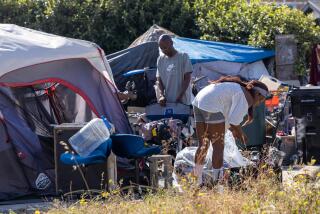Study Profiles Typical Homeless: 37, White, Male
- Share via
SANTA ANA — Homeless people in Orange County are typically white, male, single, high school graduates, about 37 years old and residents of the county for at least two years, a study released Wednesday has found.
Advocates for homeless people praised the study, considered to be the most comprehensive ever of the county’s homeless population, and said it would lead to increased funding for programs and a better understanding of the problems involving homeless people.
“There is not better data on the homeless anywhere,” said Ron LaPorte, manager of the County Health Care Agency’s alcohol programs division. “Before we were just guessing, but now we know what we’re dealing with.”
The Health Care Agency spent $150,000 for the study, which was conducted in April and May, 1992.
The agency contracted with the Social Science Research Center at Cal State Fullerton to interview 400 homeless people who lived in shelters and on the streets.
The study dispels myths that homeless people in Orange County have come here from another state or another country:
* About 85% of the 400 homeless people interviewed were born in the United States.
* And 77% said they were Orange County residents before becoming homeless.
Researchers said they used “groundbreaking” procedures to find homeless people for the project.
Gregory Robinson, director of Cal State Fullerton’s social science research center, said researchers crawled through drainage pipes, frequently visited freeway underpasses where homeless people sleep, and even rode mountain bikes to remote rural canyons to locate homeless people.
“We poked our noses in unsavory and strange places,” Robinson said. “In some cases, we found them sleeping under shrubs along the freeway with cars whizzing by. These people exist beneath our noses in Orange County and nine out of 10 times we’re not seeing them.”
Apart from constructing a demographic profile of the homeless in Orange County, the study also found that 47% of the respondents “indicated alcoholic symptoms,” with 32% reporting that they drink malt liquor--a beer with a high alcohol content--and 26% acknowledging that they drink a high-alcohol-content wine.
Christina Nereson, a program manager with the county’s Alcohol and Drug Education and Prevention Team, said the study’s findings about the availability of high-alcoholic-content beverages to homeless people would be useful in planning prevention strategies.
“We may want to know how communities feel about the marketing of these products,” Nereson said. “Do they want to take action about how low-income people are targeted as consumers of these products?”
Homeless people said in the study that the public could help. When asked what was the most useful thing someone could do, their most frequent responses were to provide jobs (37%), housing (25%), and financial assistance (12%).
Advocates for homeless people said the study was useful because it identified the needs of the homeless.
Maria Mendoza, the county’s homeless issues coordinator, said county agencies will use the study as “a tool for future planning.”
She said the county will use the findings to push for increased federal funds for more affordable housing in Orange County. “We are trying to provide services (for the homeless) with our existing resources, but housing is that missing link,” Mendoza said.
James K. Cunningham, a research analyst who oversaw the study, said the findings should change “the perception that Orange County is a suburban area, like Disneyland, without homeless people.”
This study “is going to change the attitude of officials at the federal level,” Cunningham said. “Homeless people here have multiple problems and it’s clear now that we need integrated services to deal with them.”
Looking at the Homeless
In Orange County and across the nation, ranks of the homeless are filled with white males who are approaching their 40s, are moderately educated and generally have lost hope of living in a house again. *Race
In Orange County and other metropolitan areas, the biggest percentage of the homeless is white. Generally, Latinos and blacks make up the remaining ranks of the homeless. Orange County White: 52% Latino: 21% Black: 22% Other: 5% *Los Angeles County White: 49% Latino:10% Black: 32% Other: 9% *Phoenix White: 64% Latino:17% Black: 9% Other: 10% *Portland, Ore. White: 77% Latino: 4% Black: 6% Other: 11% *Sex
In Orange County, homeless males are more likely than homeless females to live on the street, smoke, and have alcohol-related problems. Homeless females, however, are more likely to be employed and be optimistic about living in a house again soon. Orange County Males: 75% Females: 25% *Los Angeles County Males: 78% Females: 22% *Phoenix Males: 86% Females: 14% *Portland Males: 85% Females 15% *Marital Status
Contrary to the national trend, Orange County’s homeless are far more likely to be single than married. Orange County Married: 12% Widowed: 2% Divorced: 28% Single*: 58% *Nationwide Married: 61% Widowed: 7% Divorced: 9% Single*: 23% * includes 3% who reported that they were cohabiting *Education
Compared with the general population of the United States, Orange County’s homeless are more likely to have some higher education. But a smaller percentage received their college diplomas. Orange County Homeless Some high school: 25% High school graduate: 36% Some college: 30% College graduate: 9% *General Population, Nationwide Some high school: 22% High school graduate: 39% Some college: 18% College graduate: 21% Source: Orange County Health Care Agency
More to Read
Sign up for Essential California
The most important California stories and recommendations in your inbox every morning.
You may occasionally receive promotional content from the Los Angeles Times.










